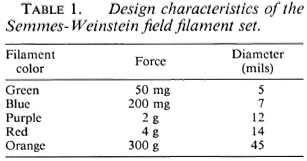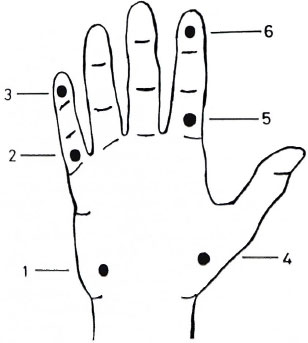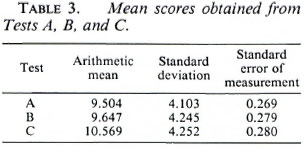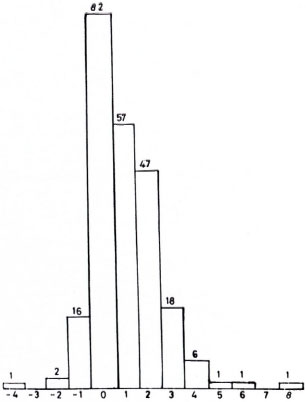- Volume 61 , Number 1
- Page: 16–9
Effect of hand soaking on sensory testing
ABSTRACT
This study investigates the effect of hand soaking on sensory testing scores in 58 patients with leprosy. Sensation was tested with Semmes-Weinstein monofilaments and scored. Patients were tested before and after soaking their hands in water for 30 minutes. A statistically significant improvement in sensory testing scores for individual nerve territories was noted. The importance of these findings should be considered when using sensory testing as an evaluative tool for nerve damage in leprosy.RÉSUMÉ
Cettte étude analyse l'effet de l'humidification des mains sur les scores btenus aux tests de sensibilité chez 58 malades de la lèpre. La sensibilité a été testée à l'aide de monofilaments de Semmes-Weinstein, et un score a été donné. Les patients ont été testés avant et après humidification de leurs mains dans l'eau durant 30 minutes. On a noté une amélioration statistiquement significative des scores des tests de sensibilité pour des territoires nerveux individuels. L'importance de ces observations devrait être prise en considération quand on utlise les tests de sensibilité pour évaluer les dommages nerveux dans la lèpre.RESUMEN
En este estudio se investigó cl efecto de remojar las manos sobre los registros de las pruebas sensoriales en 58 pacientes con lepra. Las pruebas sensoriales se hicieron usando los microfilamentos de Semmes-Weinstein, antes y después de que los pacientes hubieron remojado sus manos en agua durante 30 min. Se notó una mejoría, estadísticamente significativa, en los registros sensoriales de territorios nerviosos individuales. Consideramos que estos hallazgos deben tomarse en cuenta cuando se usan las pruebas sensoriales para evaluar el daño de los nervios en la lepra.The Semmes-Weinstein monofilaments are commonly used in the assessment of cutaneous sensation in patients with leprosy. With these filaments, a controlled force can be applied to the skin and accurate measurement of sensory loss can be made (1). However, if the skin is hard, calloused, and inflexible, as, for example, in manual laborers and leprosy patients, testing with Semmes-Weinstein filaments may not indicate the true sensory status. Although the filament applies a force, this may be poorly transmitted to the receptor system in the dermis and, therefore, may not be felt by the patient. The soaking of patients' feet in water and the application of oils is standard practice in the physiotherapy of leprosy (7). This serves to hydrate the skin, making it more supple, and thus preventing Assuring. After such soaking, hard palmar skin becomes considerably softer (3).
The aim of this study is to evaluate the effect of hand soaking on sensory testing scores, with the patients acting as their own controls.
MATERIALS AND METHODS
Patients attending the outpatient department of the Richardson Leprosy Hospital, Miraj, India, were evaluated for eligibility, and 58 patients were found suitable to be included in this study. Exclusion criteria were: a) incomplete index or little fingers; b) open cuts and wounds on the palmar surface; c) children under 16 years of age; and d) those who were unable to understand the testing procedures.
A set of five Semmes-Weinstein field filaments were used for the sensory testing. Each filament was mounted onto a steel rod made from a 3-mm diameter spoke from a motorcycle wheel. It was secured by means of a small piece of I.V. tubing slipped over it. The filaments and mounts were supplied by the Gillis W. Long Hansen's Disease Center, Carvillc, Louisiana, U.S.A., with instructions for making field filaments for sensory testing supplied by J. Bell-Krotoski. Each filament was individually calibrated to its design force of ± 5% using a single pan electric balance (Ainsworth, Type 10 N, Denver, Colorado, U.S.A). We found that the lengths varied between 32 mm and 43 mm for the different filaments at the specified forces. The filaments supplied were designed to exert the forces shown in Table 1 at a fixed length of 38 mm. Therefore, each filament used in this study was individually calibrated to its specified force. The dynamic characteristics of force delivery were not checked.

A quiet room was chosen for the testing. The testing procedure was demonstrated to the patients with their eyes open. They were expected to indicate with one finger of the other hand wherever the filament was felt. The patient was then blindfolded. Six points on the palmar surface of each hand were tested for sensation (Fig. 1). The 300 g filament was applied first to each point three times. The results were recorded as "felt" or "not felt." Accurate indication or minor degrees of misreference were recorded as "felt." No response or gross degrees of misreference were recorded as "not felt" (6). In the same way, the six points were tested with the other filaments in a sequence of descending forces. All tests were performed in the month of April.

Fig. 1. The Sites tested for sensation.
The scoring system is indicated in Table 2, with a score between 0 and 15 for the radial three points (representing median nerve territory) and similarly for the ulnar three points (representing ulnar nerve territory). Both hands of each patient were tested to provide the initial scores for each nerve territory (radial and ulnar in both hands or four scores) (Test A). The test was then repeated after 30 min (Test B), and the four scores were recorded. The patient was then instructed to immerse his/her hands in a basin of tap water at room temperature (30ºC to 35ºC) for a period of 30 min. The hands were towel dried and the sensory testing repeated (Test C). All three tests on an individual patient were performed by the same examiner, providing three sets of four scores for each patient.

RESULTS
The improvement in mean scores across the three tests is illustrated in Table 3. Table 4 shows the difference in the mean scores of three tests. The observed mean score of Test A was 9.504 ± 0.538 (95% confidence interval or C.I.). The observed mean score of Test B was 9.647 ± 0.558 (95% C.L). The observed mean score of Test C was 10.569 ± 0.560 (95% C.L). The difference of the means B-A (0.143) is not statistically significant. However, both differences of the means C-A (1.065) and C-B (0.922) are statistically significant.


The histogram (Fig. 2) shows the effect of soaking for each nerve territory. Of the 232 nerve territories tested (58 subjects with four territories each), 82 showed no change (0) in sensory scores with soaking, 131 showed improved scores (+), and 19 showed reduced scores (-). The overall trend was toward improvement.

Fig. 2. The changes in sensory scores in the four nerve territories tested in each of 58 subjects before and after soaking of the hands.
DISCUSSION
Of all the field sensory-testing instruments available, the Semmes-Weinstein monofilaments are unique in their ability to demonstrate gradients of sensibility change (2). This is of value in a) demonstrating a minimum protection threshold of sensibility, and b) using sensory testing as an index of the progression or resolution of nerve damage over time, for example, in a patient in reaction.
Our results show that soaking hands in water causes a statistically significant improvement in sensory testing scores obtained with the Semmes-Weinstein monofilaments.
It is unlikely that such a large improvement could be due solely to the patient becoming more accustomed to testing since the difference between the scores of Tests A and B was very small (0.143). Most of the patients tested were noted to have had hard palmar skin. In leprosy patients, loss of sweating secondary to autonomic nerve damage results in desiccation of the keratin layer which becomes hard and inflexible (4). The degree of impairment of autonomic function does not always correlate with the loss of sensations, although in severe cases both of these functions tend to be markedly impaired (5). Furthermore, the main source of employment in this area is agriculture with a low degree of mechanization. Patients thus employed may be expected to have the characteristic thickened palmar skin of the manual laborer.
If sensory testing is being undertaken to assess nerve function, then soaking would be expected to give better correlation between sensory testing scores and nerve function because the effect of one variable (the lack of pliability of the skin) is being reduced. Patients are often treated with hand soaking as part of a physiotherapy regimen. When performing sequential sensory testing over time the skin must be in the same state of hydration each time the test is performed.
Acknowledgment. The authors acknowledge the valuable contributions of he following stalT at Richardson Leprosy Hospital, Miraj: Dr. P. D. Samson (Superintendent), Dr. R. Rao (Medical Officer), Mr. P. Chavan and Mr. A. Kamblc (Laboratory Technicians), Mr. R. Lokhande (Physiotherapy Technician)and Mrs. N. Kolhe (Secretary). Mr. Robert Jerskey, OTR, Consultant with American Leprosy Missions, is thanked for making the filaments available to us.
We arc grateful to Dr. K. Patolc, Wanlcss Hospital, Miraj, for statistical advice. Mr. D. M. McAuley and Mr. P. A. Ewing thank their sponsors for making their elective trip possible.
REFERENCES
1. BELL, J. A. and BUFORD, W. L. The force/time relationship of clinically used sensory testing instruments. J. Hand Ther. 1(1988)76-85.
2. BELL-KROTOSKI, J. A. Light touch deep pressure testing with Scmmes Weinstein monofilaments. In: Rehabilitation of the Hand. 3rd edn. St. Louis: C. V. Mosby Co., 1990, pp. 585-593.
3. BLANK, I. H. Factors which influence the water content of the stratum corneum. J. Invest. Dermatol. 18(1952)432-440.
4. BRYCESON, A. D. M. and PFALTZGRAFF, R. E. Complications due to nerve damage. In: Leprosy. 3rd cdn. Edinburgh: Churchill Livingstone, 1990, p. 139.
5. MATHUR, N. K., PASRICHA, D. P. and SINGH, N. Comparison of the cutaneous autonomic and somatic nervous function in the lesions of leprosy. Int. J. Lepr. 39(1971)146-150.
6. NAAFS, B. and DAGNE, T. Sensory testing: a sensitive method in the follow up of nerve involvement. Int. J. Lepr. 45(1977)364-368.
7. PALANDE, D . D . and BOWDEN, R. M . Early detection of damage to nerves in leprosy. Lepr. Rev. 63(1992)60-72.
1. Elective Medical Student from Edinburgh University, Scotland; Richardson Leprosy Hospital, Miraj, Maharashtra 416410, India.
2. Elective Medical Student from Aberdeen University, Scotland; Richardson Leprosy Hospital, Miraj, Maharashtra 416410, India.
3. M.B.B.S., Richardson Leprosy Hospital, Miraj, Maharashtra 416410, India.
Reprint requests to Dr. Devasundaram.
Received for publication on 9 June 1992.
Accepted for publication on 1 October 1992.